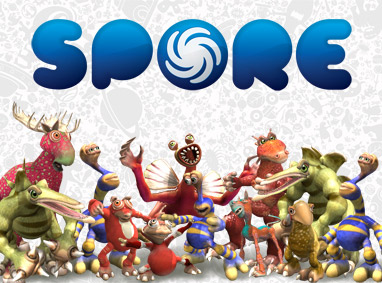Spore is More: Build Your Own Alien at Home

"It'sjust a video game!" I hear you say. Well, sure, it is. And "StarTrek" was just a television show, too.
Except thatit wasn't. The starship Enterprise sailed an impressive track from weeklyentertainment to cult program, to lucrative franchise, to archetypicalembodiment of our dreams for the future.
Spore may follow in its wake. The newtitle from powerhouse video game developer Electronic Arts, hitting the shelvesand download sites this week, is an example of art imitating science. The gameis the brainchild of Will Wright, the fellow who designed such hotentertainment properties as Sim City and Sim Earth. These games allowed playersto do what Julius Caesar had in mind: namely, run a city or build an empire(without the danger of being knifed in the Forum).
In Spore,you create life forms that compete for survival in a sort of "DNAeconomy," and seek to extend their influence from a single planet to thegalactic realm. One of its more appealing functions — building complex crittersthat appear in the game — is accomplished in Spore's Creature Creator. Thissoftware accessory gives you the parts and power to quickly design your ownaliens, starting with a basic body form and adding appendages, facial features andvarious skin textures and colors. Even serious scientists can quickly becomeenamored of this interactive Mr. Alien Potato Head. Here at the SETI Institute, Frank Drake, Jill Tarter andthis author have enthusiastically cobbled together our own pet sentients. WillWright says that his conception of Spore was significantly inspired by theastrobiology work we are doing here (more below).
This is allgood fun, and preliminary indications suggest that EA's creation could soon be therage of young gamers everywhere. But Spore may, like "StarTrek," have significant spin-offs.
That'sbecause something seems to happen to kids between the ages of 8 and 12. Many ofthem develop a compelling interest in some subject — be it dinosaurs, history,art, astronomy or even human culture. These interests are durable. If you askbiologists how long they've been interested in biology, they'll tell you"forever," but they usually mean since they were 11 (or thereabouts).
Why thishappens is unclear. Maybe nature has found that having "experts"among the population has survival value for the species. That could be just popphysiology claptrap, but irrespective of the actual reason, prepubescent kidsare like potting soil, waiting for something exciting to grow.
Breaking space news, the latest updates on rocket launches, skywatching events and more!
I askedFrank Drake how he became interested in science. "As a kid, I bicycled to Chicago's Museum of Science and Industry every week," he said. "It was justendlessly interesting, and before long I was building Tesla coils and crystalsets."
A small toyhooked SETI Institute astrobiologist Mark Showalter: "When I was ten, Igot a small prism as a present. Breaking up sunlight into a spectrum ? thatturned me on to science."
PeterBackus, a SETI colleague, credits his father for his fascination with thecosmos. "He would take me on fishing trips, and point out theconstellations."
For me, itwas movies: sci-fi films that were cheesier than an extra-large pizzamargherita. There wasn't much real science in these potboilers, but that wasbeside the point. They hooked me emotionally. That was the key. Facts, methods,the relevant mathematics ? all that stuff I could learn later.
When you'reyoung, it's the inspiration that counts — the emotional appeal.
Spore may be just a video game to mostadults — another hi-tech distraction for the kids. Maybe parents will be happythat it doesn't involve wasting bad guys or stealing cars. But its true importmight only become apparent down the road. Twenty years from now, if you ask thefolks in the labs, the domes and the field sites how they got there, they justmight answer, "Well, it was because of a game I played as a kid ? "
About Spore'screator
Will Wrighthas frequently visited the SETI Institute, and says he drew inspiration for thenew game from its various research programs. In particular, the Institute's CarlSagan Center has over 60 scientists investigating such topics as thepossibility of life on Mars (both now and in the past), other solar systemhabitats such as the moons of Jupiter and Saturn, and how life got started onEarth.
Because ofthe close relationship of the SETI Institute and Spore's visionary creator, theInstitute is offering a special "green membership" to those wishingto become part of its research efforts by joining TeamSETI. Additionalinformation on membership can be found here.
- SPACE.com TV: Reflections on Fermi's Paradox
- Video Player: Listening for Life
- Newsarama.com: Long-Awaited 'Star Trek' MMO Finally Gets Warp Speed

Seth Shostak is an astronomer at the SETI (Search for Extraterrestrial Intelligence) Institute in Mountain View, California, who places a high priority on communicating science to the public. In addition to his many academic papers, Seth has published hundreds of popular science articles, and not just for Space.com; he makes regular contributions to NBC News MACH, for example. Seth has also co-authored a college textbook on astrobiology and written three popular science books on SETI, including "Confessions of an Alien Hunter" (National Geographic, 2009). In addition, Seth ahosts the SETI Institute's weekly radio show, "Big Picture Science."
